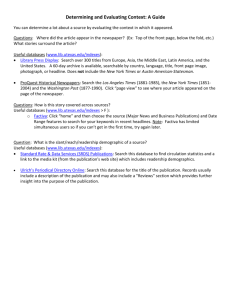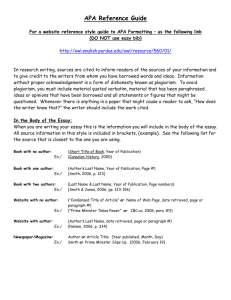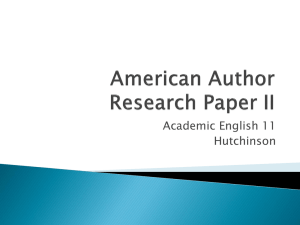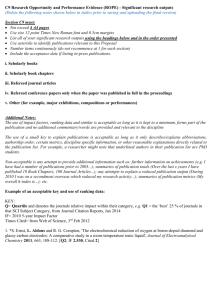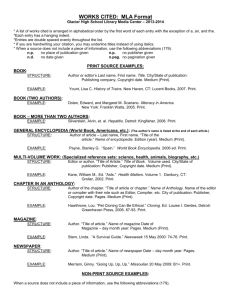How to Cite Sources in MLA and APA Format
advertisement
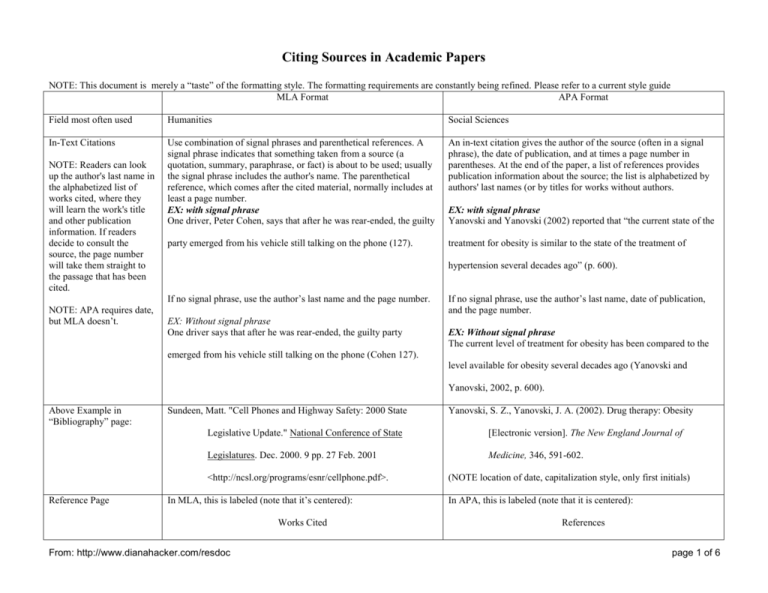
Citing Sources in Academic Papers NOTE: This document is merely a “taste” of the formatting style. The formatting requirements are constantly being refined. Please refer to a current style guide MLA Format APA Format Field most often used Humanities Social Sciences In-Text Citations Use combination of signal phrases and parenthetical references. A signal phrase indicates that something taken from a source (a quotation, summary, paraphrase, or fact) is about to be used; usually the signal phrase includes the author's name. The parenthetical reference, which comes after the cited material, normally includes at least a page number. EX: with signal phrase One driver, Peter Cohen, says that after he was rear-ended, the guilty An in-text citation gives the author of the source (often in a signal phrase), the date of publication, and at times a page number in parentheses. At the end of the paper, a list of references provides publication information about the source; the list is alphabetized by authors' last names (or by titles for works without authors. party emerged from his vehicle still talking on the phone (127). treatment for obesity is similar to the state of the treatment of NOTE: Readers can look up the author's last name in the alphabetized list of works cited, where they will learn the work's title and other publication information. If readers decide to consult the source, the page number will take them straight to the passage that has been cited. hypertension several decades ago” (p. 600). If no signal phrase, use the author’s last name and the page number. NOTE: APA requires date, but MLA doesn’t. EX: with signal phrase Yanovski and Yanovski (2002) reported that “the current state of the EX: Without signal phrase One driver says that after he was rear-ended, the guilty party If no signal phrase, use the author’s last name, date of publication, and the page number. EX: Without signal phrase The current level of treatment for obesity has been compared to the emerged from his vehicle still talking on the phone (Cohen 127). level available for obesity several decades ago (Yanovski and Yanovski, 2002, p. 600). Above Example in “Bibliography” page: Sundeen, Matt. "Cell Phones and Highway Safety: 2000 State Legislative Update." National Conference of State [Electronic version]. The New England Journal of Legislatures. Dec. 2000. 9 pp. 27 Feb. 2001 Medicine, 346, 591-602. <http://ncsl.org/programs/esnr/cellphone.pdf>. Reference Page Yanovski, S. Z., Yanovski, J. A. (2002). Drug therapy: Obesity In MLA, this is labeled (note that it’s centered): Works Cited From: http://www.dianahacker.com/resdoc (NOTE location of date, capitalization style, only first initials) In APA, this is labeled (note that it is centered): References page 1 of 6 Article in a Journal Paginated by Volume Many scholarly journals continue page numbers throughout the year instead of beginning each issue with page 1; at the end of the year, the issues are collected in a volume. To find an article, readers need only the volume number, the year, and the page numbers. EX: Ryan, Katy. "Revolutionary Suicide in Toni Morrison's Fiction." Many professional journals continue page numbers throughout the year instead of beginning each issue with page 1; at the end of the year, the issues are collected in a volume. After the italicized title of the journal, give the volume number (also italicized), followed by the page numbers. EX: Morawski, J. (2000). Social psychology a century ago. African American Review 34 (2000): 389-412. AmericanPsychologist, 55, 427–431. Article in a Journal Paginated by Issue If each issue of the journal begins with page 1, you need to indicate the number of the issue. After the volume number, put a period and the issue number. EX: Wood, Michael. "Broken Dates: Fiction and the Century." Kenyon Review 22.3 (2000): 50-64. Work from a Service such as INFOTRAC: For sources retrieved from a library's subscription database service, give as much of the following information as is available: publication information for the source; the name of the database, underlined; the name of the service; the name and location of the library where you retrieved the source; your date of access; and the URL of the service. These models are for articles retrieved through three popular library subscription services. The InfoTrac source is a scholarly article in a journal paginated by volume; the EBSCOhost When each issue of a journal begins with page 1, include the issue number in parentheses after the volume number. Italicize the volume number but not the issue number. EX: Smith, S. (2003). Government and nonprofits in the modern age. Society, 40(4), 36–45. EX: InfoTrac EX: InfoTrac Johnson, Kirk. "The Mountain Lions of Michigan." Endangered Johnson, Kirk. "The Mountain Lions of Michigan." Endangered Species Update 19.2 (2002): 27+. Expanded Academic Species Update 19.2 (2002): 27+. Expanded Academic Index. InfoTrac. U of Michigan Lib., Ann Arbor. 26 Nov. Index. InfoTrac. U of Michigan Lib., Ann Arbor. 26 Nov. 2002 <http://infotrac. galegroup.com>. 2002 <http://infotrac.galegroup.com>. EX: EBSCOhost EX: EBSCOhost Barrera, Rebeca María. "A Case for Bilingual Education." Scholastic Barrera, Rebeca María. "A Case for Bilingual Education." Scholastic Parent and Child Nov.-Dec. 2004: 72-73. Academic Search Parent and Child Nov.-Dec. 2004: 72-73. Academic Search Premier. EBSCOhost. St. Johns River Community Coll. Premier. EBSCOhost. St. Johns River Community Coll. Lib., Palatka, FL. Lib., Palatka, FL. 1 Feb. 2005 <http://search.epnet.com>. 1 Feb. 2005 <http://search. epnet.com>. From: http://www.dianahacker.com/resdoc page 2 of 6 source is an article in a bimonthly magazine; and the ProQuest source is an article in a daily newspaper. NOTE: When you access a work via a personal subscription service (e.g., America Online), give the information about the source, the name of the service, the date of access, and the keyword used to retrieve the source. Article in an Online Periodical When citing online articles, follow the guidelines for printed articles, giving whatever information is available in the online source. End the citation with your date of access and the URL. NOTE: In some online articles, paragraphs are numbered. For such articles, include the total number of paragraphs in your citation, as in the next example. EX: ProQuest EX: ProQuest Kolata, Gina. "Scientists Debating Future of Hormone Replacement." Kolata, Gina. "Scientists Debating Future of Hormone Replacement." New York Times 23 Oct. 2002: A20. ProQuest. Drew U New York Times 23 Oct. 2002: A20. ProQuest. Drew U Lib., Madison, NJ. 26 Nov. 2002 Lib., Madison, NJ. 26 Nov. 2002 <http://www.proquest.com>. <http://www.proquest.com>. EX: Accessed via personal subscription service EX: Accessed via personal subscription service Conniff, Richard. "The House That John Built." Smithsonian Feb. Conniff, Richard. "The House That John Built." Smithsonian 2001. America Online. 11 Mar. 2001. Keyword: Feb. 2001. America Online. 11 Mar. 2001. Keyword: Smithsonian Magazine. Smithsonian Magazine. EX: Online scholarly journal EX: Online scholarly journal Belau, Linda. "Trauma and the Material Signifier." Postmodern Belau, Linda. "Trauma and the Material Signifier." Postmodern Culture 11.2 (2001): 37 pars. 30 Mar. 2001 Culture 11.2 (2001): 37 pars. 30 Mar. 2001 <http:// http://jefferson.village.virginia.edu/pmc/current.issue/ jefferson.village.virginia.edu/pmc/current.issue/ 11.2belau.html>. 11.2belau.html>. EX: Online magazine EX: Online magazine Morgan, Fiona. "Banning the Bullies." Salon.com 15 Mar. 2001. 21 Morgan, Fiona. "Banning the Bullies." Salon.com 15 Mar. 2001. 21 Sept. 2004 <http://www.salon.com/news/ Sept. 2004 <http://www.salon.com/ news/feature/ feature/2001/03/15/bullying/index.html>. 2001/03/15/bullying/index.html>. EX: Online newspaper EX: Online newspaper Rubin, Joel. "Report Faults Charter School." Los Angeles Rubin, Joel. "Report Faults Charter School." Los Angeles Times 22 Times 22 Jan. 2005. 24 Jan. 2005 <http:/ Jan. 2005. 24 Jan. 2005 http:// pqasb.pqarchiver.com/ pqasb.pqarchiver.com /latimes/search.html>. latimes/search.html>. From: http://www.dianahacker.com/resdoc page 3 of 6 Basic Format for a Book Take data from the book’s title and copyright page. Use a short form of the publisher's name; omit terms such as Press, Inc., and Co. except when naming university presses (Harvard UP, for example). If more than one date, use the most recent one. For most books, arrange the information into three units, each followed by a period and one space: the author's name; the title and subtitle, underlined; and the place of publication, the publisher, and the date. Begin with the author’s name, followed by the date and the book’s title. End with the place of publication and the name of the publisher. Take the information about the book from its title page and copyright page. If more than one place of publication is given, use only the first; if more than one date is given, use the most recent one. EX: EX: Tan, Amy. The Bonesetter's Daughter. New York: Putnam, 2001. Highmore, B. (2001). Everyday life and cultural theory. New York: Entire Website Begin with the name of the author or corporate author (if known) and the title of the site, underlined. Then give the names of any editors, the date of publication or last update, the name of any sponsoring organization, the date you accessed the source, and the URL in angle brackets. Provide as much of this information as is available. To cite a nonperiodical Web document, such as a report, list as many of the following elements as are available: Author’s name, Date of publication (if there is no date, use “n.d.”), Title of document (in italics), Date you accessed the source, a URL that will take readers directly to the source EX: With Author EX: With Author & date Peterson, Susan Lynn. The Life of Martin Luther. 2002. 24 Jan. 2005 Cain, A., & Burris, M. (1999, April). Investigation of the use of When a Web address in a works cited entry must be divided at the end of a line, MLA recommends that you break it after a slash. Do not insert a hyphen. Routledge. <http://www.susanlynnpeterson.com/ luther/home.html>. mobile phones while driving. Retrieved January 15, 2000, from http://www.cutr.eng.usf.edu/its/ mobile_phone_text.htm EX: With corporate (group) author United States. Environmental Protection Agency. Drinking Water EX: With Author but no date Archer, Z. (n.d.). Exploring nonverbal communication. Retrieved Standards. 8 July 2004. 24 Jan. 2005 July 18, 2001, from http:// zzyx.ucsc.edu/~archer <http://www.epa.gov/safewater/standards.html>. EX: Author unknown EX: Author unknown Margaret Sanger Papers Project. 18 Oct. 2000. History Dept., New If a source has no author, begin with the title and follow it with the York U. 6 Dec. 2004 <http://www.nyu.edu/projects/sanger>. From: http://www.dianahacker.com/resdoc date in parentheses. page 4 of 6 EX: With Editor Exploring Ancient World Cultures. Ed. Anthony F. Beavers. 1997. U NOTE: If you retrieved the source from a university program’s Web site, name the program in your retrieval statement. Cosmides, L., & Tooby, J. (1997). Evolutionary psychology: A of Evansville. 24 Jan. 2005 primer. Retrieved July 5, 2001, from the University of <http://eawc.evansville.edu/index.htm>. California, Santa Barbara, Center for Evolutionary NOTE: If the site has no title, substitute a description, such as "Home page," for the title. Do not underline the words or put them in quotation marks. Psychology Web site: http://www.psych.ucsb.edu/ research/cep/primer.html Yoon, Mina. Home page. 29 Sept. 2004. 12 Jan. 2005 <http://www.pa.msu.edu/~mnyoon>. Article in a Newspaper Begin with the name of the author, if known, followed by the title of the article. Next give the name of the newspaper, the date, and the page numbers (including the section letter). Use a plus sign (+) after the page number if the article does not appear on consecutive pages. Begin with the name of the author followed by the exact date of publication. Page numbers are introduced with “p.” (or “pp.”). EX: EX: Brummitt, Chris. "Indonesia's Food Needs Expected to Soar." Boston Lohr, S. (2004, December 3). Health care technology is a promise Globe 1 Feb. 2005: A7. unfinanced. The New York Times, p. C5. NOTE: If the section is marked with a number rather than a letter, handle the entry as follows: Wilford, John Noble. "In a Golden Age of Discovery, Faraway Worlds Beckon." New York Times 9 Feb. 1997, late ed., sec. 1: 1+. NOTE: When an edition of the newspaper is specified on the masthead, name the edition after the date and before the page reference (eastern ed., late ed., natl. ed., and so on), as in the example just given. NOTE: If the city of publication is not obvious, include it in brackets after the name of the newspaper: City Paper [Washington, DC]. From: http://www.dianahacker.com/resdoc page 5 of 6 Article in a Magazine List, in order, separated by periods, the author's name; the title of the article, in quotation marks; and the title of the magazine, underlined. Then give the date and the page numbers, separated by a colon. If the magazine is issued monthly, give just the month and year. Abbreviate the names of the months except May, June, and July. In addition to the year of publication, list the month and, for weekly magazines, the day. If there is a volume number, include it (italicized) after the title. EX: EX: Fay, J. Michael. "Land of the Surfing Hippos." National Geographic Raloff, J. (2001, May 12). Lead therapy won’t help most kids. Aug. 2004: 100+. Science News, 15, 292. NOTE: If the magazine is issued weekly, give the exact date. Lord, Lewis. "There's Something about Mary Todd." US News and World Report 19 Feb. 2001: 53. Sample Papers http://dianahacker.com/pdfs/Hacker-Daly-MLA.pdf From: http://www.dianahacker.com/resdoc http://dianahacker.com/pdfs/Hacker-Mira-APA.pdf page 6 of 6

